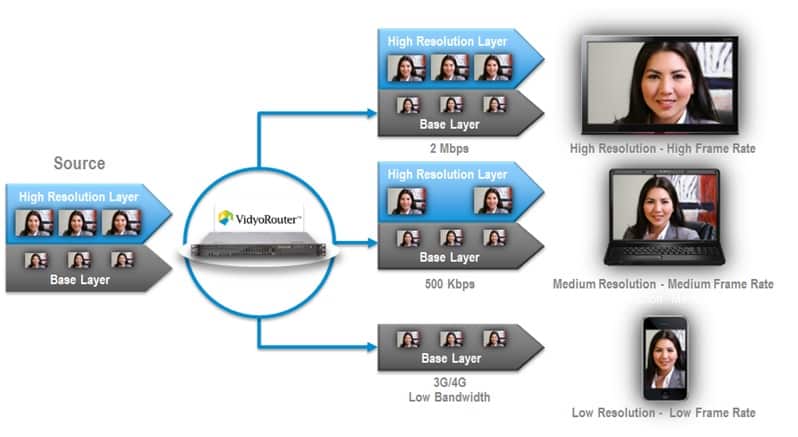SVC has had a significant impact in the videoconferencing industry
Video communications in general.
When Vidyo first introduced SVC back in 2008 very few people realized the transformative power that it contained.

VidyoRouter™

SVC is a key component of Vidyo’s VidyoRouter™ architecture and a crucial piece for providing the quality of experience that this system provides.
SVC is an extension of the H.264/MPEG-4 Advanced Video Coding standard, often referred to as AVC.
AVC has two official names: H.264 from the ITU parent, and MPEG-4 Part 10 from the ISO parent.
It appears that people coming from the communications space tend to refer to AVC as H.264, whereas people coming from the broadcast/entertainment space tend to refer to it as AVC or MPEG-4.
AVC has been very successful and is the standard used in practically all modern digital video applications: from videoconferencing and YouTube, to Blu-ray DVDs and the iTunes store.
As with any new technology, it can be difficult in the beginning to fully understand how SVC works, what systems and functionalities it makes possible and
What implications it may have for the entire industry.
This article is intended to provide some facts as well as insight into SVC, how Vidyo’s VidyoRouter uses SVC in its various functions, as well as the role that scalability has played and will continue to play in the world of video communications.
Scalable Video Coding
When Vidyo first introduced SVC back in 2008 very few people realized the transformative power that it contained. Most believed that it is just a better codec, possibly with some improved error robustness.
SVC is a key component of Vidyo’s VidyoRouter™ architecture and a crucial piece for providing the quality of experience that this system provides.
SVC is an extension of the H.264/MPEG-4 Advanced Video Coding standard, often referred to as AVC. AVC has two official names: H.264 from the ITU parent, and MPEG-4 Part 10 from the ISO parent.
It appears that people coming from the communications space tend to refer to AVC as H.264, whereas people coming from the broadcast/entertainment space tend to refer to it as AVC or MPEG-4.
AVC has been very successful and is the standard used in practically all modern digital video applications: from videoconferencing and YouTube, to Blu-ray DVDs and the iTunes store.
As with any new technology, it can be difficult in the beginning to fully understand how SVC works, what systems and functionalities it makes possible, and what implications it may have for the entire industry.
This article is intended to provide some facts as well as insight into SVC, how Vidyo’s VidyoRouter uses SVC in its various functions, as well as the role that scalability has played and will continue to play in the world of video communications.
